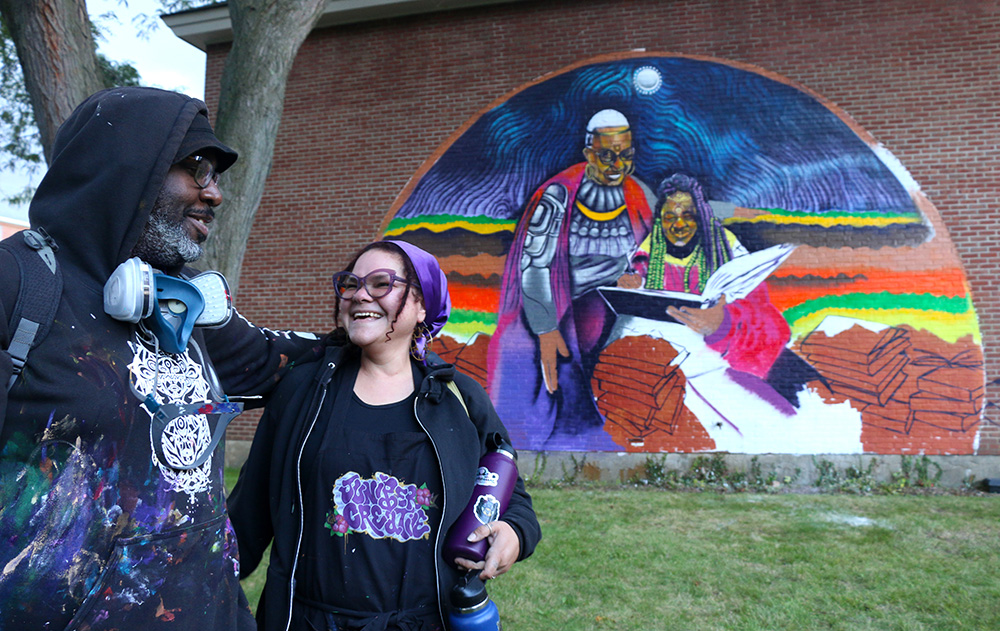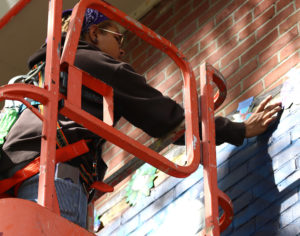Education department launches mural creation

Will Kasso Condry and Jennifer Herrera Condry of Juniper Creative Arts take a break from working on the mural in front of Alliot. Photo by Dakota Thomas
Elizabeth Quam | Staff Writers | equam@mail.smcvt.edu
Students, faculty, staff, and community members gathered outside Alliot on Monday, Oct. 3 to celebrate the unveiling of the first ever community mural at St. Michael’s titled,“The Power and Joy in Access to All Stories.” At the unveiling, multiple people spoke about the process of creating the brightly colored intricate mural and the goals they have for it.
Rebecca Haslam, professor of Education and member of the common reading committee, began the celebration with a quote from bell hooks. “The function of art is to do more than tell it like it is – it’s to imagine what is possible, ” Haslam said. Haslam then went on to explain that at a predominantly white institution, the mural aspires to tell everyone’s stories and highlights the diversity we wish to realize here.
The mural was created to commemorate the 10 year anniversary of the education department’s common read. Each year, the education department selects a book with the main theme of social justice for undergraduate and graduate students in the program to read. With recent efforts nationwide to ban and challenge books, the common read committee, made up of Professor Valerie Bang-Jensen, Professor Haslam, Professor Kristen Hindes, Professor Amy Knight, Professor Stacy Simonyi, and Professor Rebecca Wigglesworth, decided to do something bigger than usual. “We came up with this piece of art because it is powerful and long lasting and impactful,” Professor Wigglesworth, instructor in the education department and member of the common reading committee said.
The mural was produced by artists Jennifer Herrera Condry, Will Kasso Condry, and Alexa Herrera Condry, from Juniper Creative Arts. Juniper Creative Arts is a Black and Dominican family art collective that primarily produces community murals that center black and brown stories. Their art has many inspirations such as spiritual and cultural lineage, hip-hop culture, urban art, the mystical, and the natural world. They have been working since 2020 to help communities tell stories through art. Juniper Creative Arts do not only create murals, Jennifer Herrera Condry is a herbalist and Alexa Herrera Condry is an artist and photographer as well. Will Kasso Condry was the inaugural winner of the Vermont Prizein July of this year, which celebrates the top visual artists in Vermont.
The mural has multiple layers of representation and meaning. The focus of the mural is an older woman and a younger woman. According to Jennifer Herrera Condry, the older woman is telling stories to the younger woman who is writing them down. This represents the preservation of stories through oral history and books. The subjects of the mural are members of the St. Michael’s community, Information Technology Associate, Billie Miles and student, Kaltumo Ibrahim ’23.
Miles has been a part of the St. Michael’s community for many years. She graduated in 1976 and came back to work as the director of information technology in 1995. She now works part time as an information technology associate. Miles was part of the visioning process, and after the idea was conceptualized, was invited to be a reference model. Miles said she is honored to be a part of the project. And she said it is really weird seeing herself on the wall of Alliot and she is still wrapping her head around it.
The Education Department statement explains the mural is intended to “affirm the identities and experiences of Black, Indigenous, and other People of Color, people with disabilities, people of all genders, and other people who experience oppression, erasure, and social justice.” The mural is a visual statement as to what St. Michael’s aspires to be. “To be more diverse, more equitable, and more inclusive,” said Miles.

Around the outside of the mural there is a portal that represents a window. “Windows foster empathy so you can see others and learn about their stories,” psychology and education major Amy Hylen ’25 said. “The portal in the scene allows us to ‘find joy and power in access to all stories’ which is our education department common read theme.” There are also intangible mirrors represented in the mural that allow members of the community to see themselves. “Mirrors foster representation so you can see yourself in a story,” Hylen said.
The background of the mural reflects Vermont’s natural environment. The books surrounding the subjects are stacked in rock formation, with cascading water, and mountain ranges in the background. The flowers around the portal are sunflowers, poppies, and trilliums. There are also bees, butterflies, and hexagon shapes.
The process of creating the mural had multiple steps that involved different members of the St. Michael’s community. First, Juniper Creative Arts held a session to visualize the design with students, faculty, and staff. Then they held workshops for four days where students could participate by cutting out forms, priming the cloth, and painting the shapes.
Secondary education major, Camile Gallagher ’24, participated in the workshops, and painted a trillium that is part of the mural. “They taught us a new technique where you paint and then you smack it onto a paper towel and then that way the paint dries quicker so you can easily shade it,” Gallagher said. Gallagher is excited to be a part of something that will stay on campus for a long time, “It is cool that I can come back and be like ‘my flower is on that mural.’”
The mural has gotten a positive reaction around campus. “I find the mural breathtaking, truly,” Vice President for Student Affairs, Dawn Ellinwood said. “The mural is a beautiful creation that resulted from three very intentional, talented artists that infiltrated our community and through many campus community conversations, created this beautiful piece. A remarkable process with a remarkable result.”
For Juniper Creative Arts, one of the hardest parts of painting a mural is deciding what paint colors to bring because they often do not know precisely what the concept is going to be, until they get to the location. For them, their murals are “finger-prints in a way, because even though the model is consistent, each one is so very different from the last,” Will Kasso Condry said. “It is

